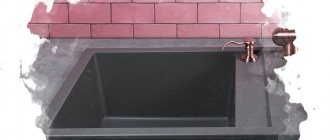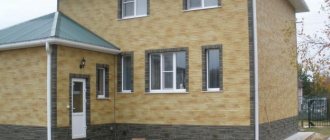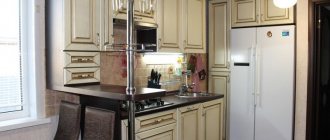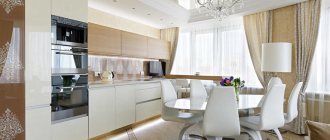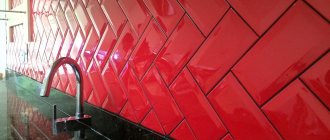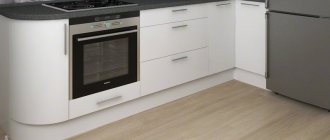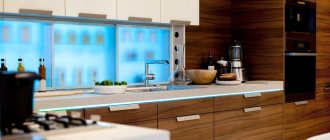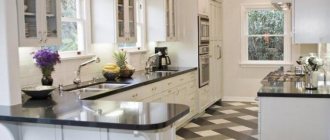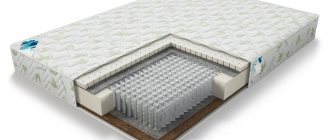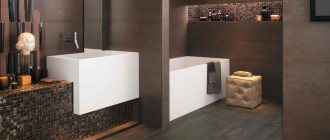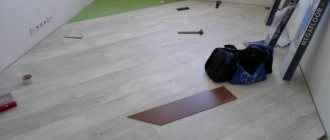The room in which the kitchen is located is rightfully considered one of the most important. This is where food is prepared, guests are received, and the whole family gathers every day. It is essential that the room is functional, safe and aesthetically pleasing. Every housewife is concerned with questions of how and what to paint the walls in the kitchen. The choice of materials for repair work must be approached very carefully. Today, stores are filled with a variety of offers. paint coatings, it is quite difficult to choose the right paint.
Painting a wall with different colors of paint.
What paint to paint the walls in the kitchen
Choosing paint for painting walls.
Deciding which composition is ideal and how to apply it, choosing color and texture - these are the most important questions that every housewife asks when starting a kitchen renovation.
Choosing the texture and color of paint for the kitchen.
All surfaces in the kitchen, such as walls, tiles, furniture and floors, should be easy to clean from dirt, resistant to wet cleaning and temperature changes, resistant to fungus and mold, and at the same time look attractive. A good mood for the whole day is guaranteed if you have breakfast in an ideal kitchen.
Benefits of painting kitchen walls
The main advantages include the following:
- water resistance is the main parameter when choosing paint;
- variety of colors, color change using tint;
- not difficult to apply;
- no pungent odor;
- environmental Safety;
- fire safety;
- quick drying (from 2 hours);
- breathability (which prevents the appearance and proliferation of microorganisms);
- high adhesion to the surface;
- long service life (up to 15 years);
- affordable price.
Advantages of coatings
An excellent choice for the kitchen is washable paint.
Designers have been using paint and varnish materials when decorating for quite some time now, instead of standard wallpaper, tiles or panels.
Why is paint preferable for decorating kitchen walls? The answer to this question is quite simple. The widest palette and the ability to mix tones allows you to choose absolutely any shade. Practicality, low cost, ease of care and application make paint and varnish materials indispensable for designers. Housewives value them for their excellent moisture resistance, wear resistance, resistance to various mechanical influences and the ease of changing the interior.
The advantage of using modern paints
When using paint, cost is taken into account. When compared with other finishing materials, paint and varnish materials are much cheaper, so you can repaint the walls at any time.
Tools for painting walls and ceilings.
Advantages of coloring compositions:
- the ability to create a unique interior;
- wide palette of shades;
- minimal risk of damage to the coating by pets;
- long period during which the attractive appearance is maintained;
- easy to clean;
- does not require much effort during application;
- if minor defects appear, they can be corrected;
- the ability to easily change the interior design.
Please note: Types of paint for glass painting
Choice of colors
Choosing paint colors for the kitchen, color palette.
To decide what to paint the walls in the kitchen with, it is important to understand what the room will be used for most often and what mood it should convey.
For example, red color in the interior increases appetite and blood pressure, and also causes discomfort when staying in such a room for a long time. Designers use this color with caution when decorating kitchens.
Kitchen design with red walls.
The orange tint lifts the mood and increases vigor, but in excessive quantities it can irritate the optic nerves.
Kitchen design in warm colors, orange walls.
If you often host family dinners or tea parties, then yellow in the interior is your assistant. It calms and improves the gastrointestinal tract. And dark green , purple and gray colors reduce appetite. Pure white evokes an association with a hospital, and the blue color conceals the space.
It is not at all necessary to paint the walls with just one paint. You can highlight the cooking area or separate the dining group, draw stripes or geometric shapes on the surface.
Separation of kitchen zones using color.
The color scheme should be in harmony with the kitchen set and your mood, that is, it should fit into the kitchen design. After all, the walls in the kitchen can be repainted over time. This is not as important as choosing the color of the walls in the children's room.
How to care for walls after painting
If you follow the rules during the painting process, the finish can last a very long time. Some practical recommendations will help you keep your decorated walls in good condition:
- If the kitchen was painted with a silicone-based mixture, the surfaces should not be exposed to alkaline detergents.
- Surfaces treated with acrylic paints should be washed with napkins soaked in soapy water (the liquid should be prepared with laundry soap).
- Abrasive pastes are suitable for water-based compositions. However, cleaning should be done carefully so as not to damage the finish.
- It is necessary to exclude sharp objects if the walls were treated with a latex mixture.
In conclusion, it is worth saying that compositions with a cleaning effect are considered the most functional. With their help, cleaning the kitchen becomes easier, and its interior is transformed.
Types of compositions
Classic kitchen in yellow.
Manufacturers suggest using the following when painting walls:
- Water-based paints , which are a type of water-dispersion composition. They are characterized by the absence of odor, environmental friendliness, the ability to dry quickly and “breathe”. Stains that get on a kitchen wall painted with this composition can be easily removed with a regular rag.
- Alkyd - they smell bad, do not “breathe”, dry very quickly, do not crack and have a high degree of elasticity. They are highly flammable.
- Acrylate is one of the most expensive paint options. It is a mixture of acrylic and latex compounds, characterized by wear resistance and durability. It does not fade in the sun and is not deformed.
- Silicone - relatively recently appeared on the market, are quite expensive and are used for painting plastered textured walls. This is a new generation composition that meets all the requirements for interior paints.
- Latex - do not allow moisture to pass through, dry quickly, forming a protective crystalline film on the surface. They belong to the class of washable interior paints, which are not afraid of chemical detergents.
- Acrylic paints for the kitchen have a wide range of colors, are odorless and dry quickly. When applied, a special film is formed on the surface, which protects the painted wall from abrasion. The color is bright, with a pleasant matte and silky texture.
Painted walls in the kitchen with water-based paint.
Painting the walls in the kitchen with acrylic paint. Some brands offer a variety of decorative compositions that differ in texture, metallic tint or ability to glow in the dark. Some types of dyes imitate the texture of brick or wood. Such paints are environmentally friendly, easy to clean, do not absorb dust and have a high level of wear resistance.
Textured painting of walls in the kitchen using paint.
The assortment of almost any hardware store includes glossy, matte and semi-gloss coatings. Painting kitchen walls with glossy compounds should be done on a perfectly flat surface without rough edges or dents. Any defect will be noticeable. It is worth remembering that a reflective surface visually enlarges the room and hides small spots of dirt. But on a matte finish, on the contrary, any stain will be clearly visible.
Glossy paint for painting walls in the kitchen.
Painting the walls in the kitchen should be done with a composition that is highly moisture-resistant and wear-resistant . The kitchen is a real military training ground for dyes: temperature changes, condensation, grease flying during cooking, and dirt stains. If a painted wall cannot be cleaned of debris and dust, then such a surface will quickly become unusable. The composition must contain elements that prevent the appearance of fungus and mold.
Kitchen design in ethnic style.
The paint should be easy to work with. A parameter such as hiding power is responsible for this. The composition and distinctive characteristics are always indicated on the packaging.
Water-based paints: advantages and disadvantages
One of the most popular compositions is water-based paint for the kitchen. Its advantages are as follows:
- One of the most important advantages is environmental friendliness. Such coloring compositions are perfect for indoor interior work.
- Creating a natural microclimate in those rooms where the walls are covered with water-based paint. Such compositions allow the walls to “breathe”, preventing the formation of dampness and fungus.
- There are no unpleasant odors when applying the paint.
- It is very easy to care for such surfaces, since walls painted with water-based paint can simply be wiped with a dry cloth to remove dirt.
- Easy to use. The paint is applied in a thin layer, without causing the risk of sagging, resulting in an even coating.
- Fast drying period.
The disadvantages of this composition are that the paint is not washable, so any serious cleaning in this case is excluded . The maximum that can be done is to wipe the coating with a damp cloth, but washing such walls is prohibited.
Advice! For this reason, it is not advisable to use water-based compounds in areas where serious contamination may occur.
It should also be noted that such a finish is fragile, since coatings lose their attractive appearance within a couple of years after application of the composition. Although in recent years, water-based compositions have appeared that can maintain their attractive appearance for more than five years.
Choosing washable paint
An example of washable paints for painting walls in the kitchen.
Everyone decides for themselves what paint to paint the walls in the kitchen. Water-based paints are great for this. You can also use any polymer compositions, with the exception of PVA-based dyes. This paint is not resistant to moisture and is only suitable for dry surfaces.
The walls in the kitchen are painted and washable.
Silicone, latex and acrylic kitchen paints are also very popular due to their properties and cost. Don't skimp on the choice of paint. Make the right choice of paint for the walls; the lifespan of the entire room depends on its quality and characteristics.
Surface paint
Paints are also distinguished by the resulting surface after painting. The following types are distinguished: matte, glossy and semi-gloss.
Glossy - most often it is chosen for painting walls in kitchens. The surface must be perfectly smooth, otherwise all flaws will be visible. Gloss on the wall looks more elegant, does not get dirty as quickly and is easier to clean. Because of the shine that comes from glossy paints, the kitchen will visually appear larger and more voluminous; this is a good option for small kitchens.
Matte - hides surface unevenness.
Semi-gloss - often used in the kitchen. Compared to glossy ones, their shine is not so bright, but otherwise the characteristics are similar.
How to prepare walls for painting
Preparing walls, leveling, in the kitchen for painting.
Painting kitchen walls must be done on a perfectly smooth and even surface. First, you need to remove all stains, traces of dirt and grease, soot, old wallpaper, tiles and other materials. Any crumbling plaster must also be removed.
Fungus and mold, if present, are removed mechanically. The surface in this place is treated with special antibacterial compounds. Potholes are covered with cement or gypsum-based plaster.
Applying paint to decorative putty for kitchen decoration.
The walls are leveled using plaster or moisture-resistant acrylic putty, applied in two or three layers. To increase adhesive properties, primer is applied after each layer.
A deep penetration primer is preferable. It is not expensive and can be diluted with water 1:1
It is recommended to choose moisture-resistant putty from the same company as the paint, because their compatibility will determine how long the paint will dry, the appearance and strength of the coating, resistance to various damages and resistance to wet cleaning.
Creating a design in the kitchen with your own hands, painting the walls.
To obtain an ideal surface, the dried final layer must be sanded.
Design solutions
To make the kitchen cozy and look beautiful, you cannot do without decor. Using paint to implement ideas in the interior is quite simple. Wall painting is growing in demand, but not everyone can do it themselves: the work is painstaking.
Sometimes painting solves some problems: uneven walls, low ceilings. Floral motifs are appropriate on the kitchen walls.
Multiple colors
Over time, walls painted in one color seem boring and quickly become boring. Decorating comes to the rescue.
Designer interior painted in two colors.
The material has the following advantages:
- easy to apply;
- does not contain toxic substances;
- it's easy to take care of.
Pay attention to: Primer for wood for painting: description, types, application
You can apply coloring in two colors (red and black, blue and yellow, blue and pink, etc.).
Solid colors
Dark colors are rarely used for the kitchen (unless the kitchen set is white and occupies a corner in addition to the wall). Visually, dark colors make the room smaller, so they can only be used in spacious kitchens with good lighting. The color yellow is associated with the sun; it creates comfort and increases appetite. Red is considered quite aggressive and can cause irritation. Green has a calming effect and reduces appetite.
Those who intend to lose weight are recommended to paint the kitchen walls in cool shades of purple, olive, and gray, which reduce appetite.
A kitchen painted in emerald, pistachio, and light green colors looks attractive. White is associated with sterility, so it is recommended to combine it with other tones.
Light green color in kitchen interior design.
Shades of orange increase appetite, but if there is a lot of it, irritability appears. Blue looks too gloomy and is rarely used in the kitchen.
Textured paint design
Using relief patterns applied to the wall, a textured design is created. This technique requires rollers with rubber decorative tips. You can use stencil options made from polymer film.
Read further:
Painting bathroom walls: choosing paint and surface preparation, step-by-step painting instructions and different methods
Kitchen paint: types of paint compositions, wall preparation and painting instructions
Painting walls with water-based paint: surface preparation, choice of paint and step-by-step instructions for painting
Painting walls over plaster: choosing paint and step-by-step instructions for completing the work
Painting ceramic tiles in the bathroom, kitchen, floor: choosing the necessary paint, step-by-step technology
How to paint the walls in the kitchen
Modern design in the kitchen.
The first step is to prepare everything that may be required in the process:
- Work clothes that you won’t mind throwing away and protective equipment (goggles, respirator)
- Solvents and wipes for cleaning hands and tissues
- Specialized tools: brushes, rollers, masking tape, paint container
- Kitchen wall paint
To begin with, it is recommended to use a medium-sized brush to go through all the corners, hard-to-reach places and the perimeter of the baseboards, then apply the composition to the entire surface with a wide brush or roller.
Work is carried out from top to bottom from the ceiling. Using masking tape, seal the ceiling in the places where it connects to the wall. This allows you to prevent the paint composition from getting onto undesirable surfaces and create an even color.
The quality of the coloring also directly depends on the quality of the roller. Experts recommend using a mohair roller to paint the kitchen area.
Painting kitchen walls with a mohair roller.
It is best to do strokes simultaneously in different directions: from right to left and from top to bottom. Shading will help distribute the paint on the surface as evenly as possible, preventing the appearance of streaks and streaks.
Water-based paints are applied using a W-shaped motion. Then soft vertical and horizontal strokes alternate from the ceiling to the floor. If you plan to apply the substance in two layers, then the sequence should be the first layer vertical, the second horizontal. If in three, then vertical-horizontal-vertical. At the same time, water-dispersed compositions do not require complete drying to apply subsequent layers.
Painting walls with a roller yourself is a very labor-intensive process. The composition must be evenly distributed over the entire surface, carefully rolling it out. Air bubbles and debris falling onto the painted layer must be removed mechanically.
Painting tools
Kitchen wall paint is applied to the surface using the simplest tools:
- wide brush (about 10 cm),
- narrow brush for corners and joints,
- paint roller,
- paint tray,
- telescopic handle for roller,
- ladder,
- masking tape,
- latex gloves.
Instead of a roller, you can use a spray gun.
If the choice fell on oil or alkyd paint, then it is necessary to provide respiratory protection during work.
The furniture is taken out of the room or covered with plastic film, the floor is covered with newspapers, the ceiling is covered with masking tape around the perimeter, the baseboards are treated in the same way, or they are temporarily dismantled.
Safety
Minimal protection when painting walls.
When carrying out paint and varnish work with your own hands, you need to follow the simplest rules:
- Be sure to wear safety glasses and rubber gloves to prevent dye from getting on your skin and mucous membranes. Hair is hidden under a headdress.
- Use only serviceable, stable ladders and stands.
- The air in the room should flow freely at all times. But you should not allow drafts to form.
Painting the walls in the kitchen with your own hands is a complex but very interesting process. The final result directly depends on the efforts you put in and the patience you show.
Further coverage
To avoid smudges, use a paint bath.
Painting the walls in the kitchen requires a lot of preparation, so you need to wait a little. The first layer is the starting putty. It is necessary because the surface can absorb moisture and the coating will be uneven. The putty contains fine sand, and the layer will be about 3mm wide, so you don’t have to worry about its strength. The mixture must be diluted in accordance with the instructions so that it fits correctly. The mixture dries in less than an hour.
First, corners and hard-to-reach places on one wall are coated with a brush, and then the rest of the surface is painted with a roller.
Also, during putty, a special mesh is used, on which another layer is applied. There are many articles discussing the pros and cons of this method. After applying the putty, sanding occurs, followed by the finishing putty. The finishing mixture does not contain sand, so the layer will be perfectly smooth. The paint will definitely not be absorbed into this layer.
Gallery: Kitchen wall painting design
There are no similar articles.
Choosing paint
Paint and varnish products are mainly divided into three large groups:
- Water based paint.
Water based paint - Solvent paint.
- Waterborne paints.
You can find out how to lay tiles in the kitchen here.
Water-based
Advantages of paint:
- dries very quickly,
- does not have a sharp pungent odor,
- the paint is non-toxic,
- Plain water is sufficient to wash hands and other surfaces.
This type of paint consists of paint and a pigment that is added to it.
To acquire water-repellent qualities, which is important for the kitchen, the paint must contain special substances. Alkyd additives are also added to some paints to increase durability.
Alkyd
The most damage-resistant type of paint. Can be used both outdoors and indoors. A damp kitchen environment is a great place to paint with alkyd paint. Sometimes the floor and ceiling are also painted with it.
Advantages:
- brightness,
- moisture and color resistance,
- economical,
- The paint is applied easily and quickly, even when painting the ceiling.
Water-based alkyd paint
Epoxy
Paint consisting of resin and epoxy components. Good water resistance and wear resistance . Expensive, therefore more often used on an industrial scale.
Water based epoxy paint
Polyurethane
Such paints are used mainly for painting metal, wood, concrete, objects that come into contact with humans, drinking water and food (tanks, swimming pools, malthouses, grain storage areas and other products), polyurethane floors. Very rarely used for interior decoration.
water-based polyurethane paint
The paint must be diluted with a solvent and is quite difficult to obtain.
You can find out about design ideas for the kitchen here.

